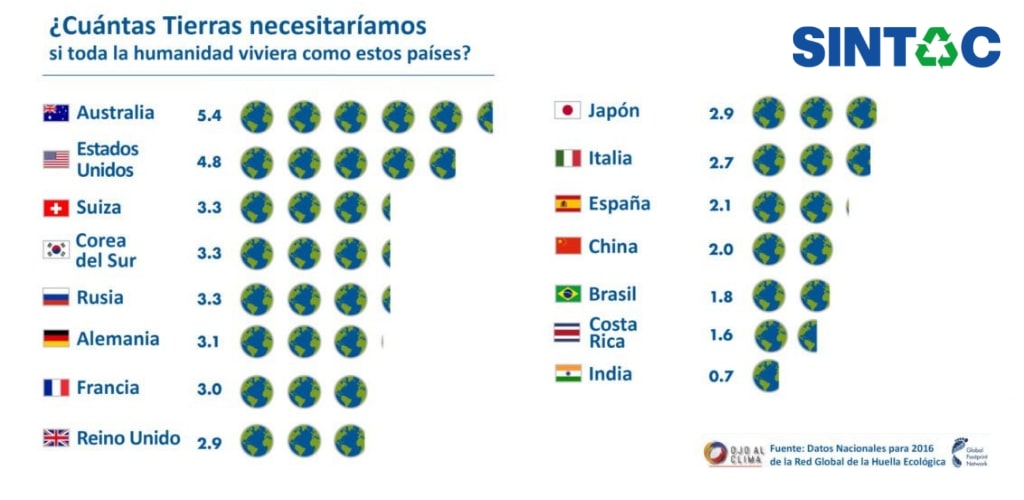Ecological Footprint
The way we, as humans, live on Earth puts pressure on the environment. This is known as our ecological footprint. By measuring our ecological footprint, we can know our impact on the planet and work to reduce the number of greenhouse gases produced by our daily activities, thus acting against global warming.
What is the ecological footprint?
Humans need food, shelter and heating (in some places) to survive. Our planet’s ecological resources help to meet these needs. But how many resources do we consume? This question can be answered using the Ecological Footprint.
Just as a bank statement records income versus expenditure, the Ecological Footprint measures a population’s demand for resources and natural ecosystem services.
On the demand side, the Ecological Footprint measures an individual’s or a population’s demand for food and plant-based fibre products, livestock and fish products, timber and other forest products, space for urban infrastructure, and forests to absorb their carbon dioxide emissions from fossil fuels.
On the supply side, the biocapacity of a city, state or nation represents its biologically productive land and sea area, including forest land, grazing land, cropland, fishing grounds and built-up land.

The Ecological Footprint can be calculated for an individual, a city, a region, a country and the entire planet.
Difference between ecological footprint and biocapacity
The difference between the Ecological Footprint and biocapacity is determined by several factors. Our personal Footprint is the product of what we use and how efficiently it is produced. Biocapacity per person is determined by the number of hectares of productive area, the productivity of each hectare and the number of people (in a city, a country or the world) who share this biocapacity.
Many countries are “in the red”, meaning that they use more natural resources (Ecological Footprint) than their ecosystems can regenerate (biocapacity). They have an “ecological deficit”. Conversely, when a country’s biocapacity is greater than the Ecological Footprint of its population, the country has an “ecological reserve”.
Nations (also cities and states) can have ecological deficits if they deplete their own resources, for example, by overfishing; importing resources from other areas; and/or emitting more carbon dioxide into the atmosphere than their own ecosystems can absorb.
What is Earth Overshoot Day?
When the entire planet has an ecological deficit, we call it “overshoot”. At the global level, ecological deficit and overshoot are the same, as there is no net import of resources into the planet.
Overshoot occurs when
- THE ECOLOGICAL FOOTPRINT OF HUMANITY -> THE BIOCAPACITY OF THE EARTH
Earth Overshoot Day marks the date when humanity’s demand for ecological resources and services (Ecological Footprint) in a given year exceeds what the Earth can regenerate in that year (biocapacity).
Where does the data come from?
Each country has offices that collect data on the country’s economic activities, agricultural productivity, imports and exports, energy consumption, etc. These data make it possible to calculate how much food (apples, pasta, orange juice) has been consumed, how much wood has been used to make furniture, how much energy is used by households, and so on. These offices report the data to international bodies. Global Footprint Network, which calculates the Ecological Footprint of more than 200 countries, obtains the data from these international offices and applies it to its extensive accounting database to calculate how many resources each country consumes.

Calculating the Ecological Footprint
The calculation of the ecological footprint takes into account the following two factors:
- Earth’s biocapacity, i.e. the planet’s capacity to produce resources; Human activity and its ecological impact, i.e. the resources consumed by humans and their waste.
The resources consumed by each individual are subtracted from the resources generated by the planet during a year. The ecological footprint is measured in global hectares. On average, a European would need 4.5 hectares, while a North American would need 6.6 hectares and an African 2.7 hectares.
The results of this global calculation show that the planet’s capacity to meet the needs of its inhabitants is insufficient.
To help you calculate your ecological footprint more easily, WWF has provided a free online ecological footprint calculator. https://footprint.wwf.org.uk/#/
You can also calculate your ecological footprint with the Global Footprint Network.
https://www.footprintcalculator.org/home
How to reduce your environmental footprint:
A significant part of the ecological footprint is due to greenhouse gas emissions from human activity. In fact, the ecological footprint of individuals depends predominantly on their lifestyle.
To limit greenhouse gas emissions and thus reduce the ecological footprint, it is essential to change people’s lifestyles by adopting a few simple habits.
Tips to reduce the ecological footprint
Reduce meat consumption.
Recycle and give new life to materials.
Optimise energy consumption.
Opt for a green energy company.
Produce your own energy.
Move in a sustainable way.
Ecological footprint by country: examples in 2022:
Not all countries exert the same pressure on the Earth, and a country’s ecological footprint is calculated from the ecological footprint of its inhabitants.
According to the Global Footprint Network, in 2016 the global ecological footprint was 2.7 gha for a biocapacity of 1.6 gha. This means that 1.7 planets were needed that year to meet human needs.














